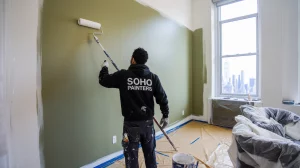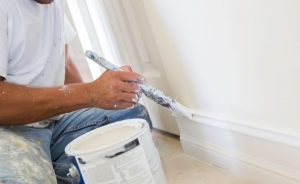A fresh coat of paint is an easy way of adding a fresh new look to an old and drab room. But while it may be easy to just slap on some paint to your walls, the type of paint roller you use can actually play a role in how the results will turn out.
So if you’re leaving streaky paint on your walls, you might be using the wrong nap size for the job. But there’s no reason to mess up your next makeover as this article will discuss which nap size is right for getting that smooth paint finish.
What is a nap paint roller?
When picking out a paint roller for your DIY project, you’ll notice that there are a number of types and sizes to choose from. To an untrained eye, these sizes won’t seem to matter – but in reality, they actually make a big difference.
A nap is a cover attachment of a paint roller that usually comes in natural, synthetic, or blended fibers. Each type of fiber will work best on different paints, so it’s handy to know which one is appropriate to get flawless results.
For instance, natural fibers like lamb’s wool and mohair will work best with oil-based paints; while synthetic fibers like polyester and nylon will work best with acrylic and latex paints.
Does the nap size matter when painting?
If this is your first wall painting project, nap rollers may look like fuzzy attachments that come in different colors and sizes. But similar to the fibers, you’ll also have to choose the right nap size for your roller if you want your walls to get perfect coats.
The nap size refers to how thick its fibers are, so the one you’ll choose will depend on the type of wall texture and surface you’re going to paint.
The general rule is that thicker naps will hold more paint, while thinner naps will work better on smoother surfaces. The standard roller handle size is 9 inches but if you need to paint trims or crevices, smaller handles are also available.
How do you choose a nap for painting?
Now that you know that each size has its own purpose, you have to keep in mind that the nap you choose will depend on what kind of wall surface you’re going to paint. So here’s a short list of wall types you might work with to help you figure out the right nap size to get:
3/16-inch or ¼-inch
These sizes have the shortest nap fibers, so they tend to look flatter than the other ones. They’re also prone to hold less paint but can spread easily, so they’re more suitable to use on smoother wall textures. So only go with this size if you’re planning on painting untextured plaster, smooth drywall, or sanded-down wooden walls to get the best results. Avoid using these on textured walls as their short fibers will have a hard time painting over their grains.
3/8-inch or ½-inch
These sizes are great to use on most interior walls as the length of their nap fibers can go over grainier surfaces. So they’re suitable for slightly textured wood and drywall, smooth concrete, and acoustic tiles. They’re also great for coating previously painted matte walls, so you can use these to give your room a refreshing new makeover.
¾-inch or 1-inch
These nap sizes work well on more textured surfaces as their fibers are effective for covering coarse walls. So use these if you’re going to paint textured stucco, plaster, or concrete walls to get a uniform coat. Avoid using these on smoother walls as their thick fibers may create a stippling effect that becomes more evident on flatter surfaces.
1 ¼-inch or 1 ½-inch
Since these have the thickest nap fibers, they will have the most capacity to absorb paint. So only use these when you need to coat really textured surfaces, like brick, concrete, stucco, or rough wooden walls. With consistent pressure, the length of its fibers will be able to cover their cracks and crevices to create an even coat of paint.
If you use these on smoother surfaces, you might end up using more paint than what’s needed that’s why your walls might look streaky and uneven.
Tips for painting with nap rollers
Once you have the right nap sizes for your walls, here are a few tips and tricks you can do to create the perfect paint finish:
- Before painting, wrap your nap roller with tape then slowly remove. This will reduce the number of lint that will stick to your wall to get a smoother finish.
- Remember to wet your nap rollers prior to painting as this will prep them to absorb as much paint as possible. Squeeze out the excess water or dab them with paper towels to avoid mixing water with your paint.
- To prevent roller marks, make sure not to dip your nap into too much paint. But if you see any streaks when painting, go over the surface a few more times to distribute the paint evenly.
- But if the marks only appear once the paint is dry, you can correct the damage by giving it another coat using the opposite direction as you rolled the paint the last time.
- If you can, get the higher-quality nap rollers as these will last longer and will give better painting results. Cheaper naps have the tendency to shed, so they’ll leave fibers all over your wall no matter how much prepping you do beforehand.
What nap size do professional painters use?
Professional painters will adjust the nap size depending on what wall texture they’re painting. But they’ll usually use 9-inch roller handles for smaller projects such as bathroom walls, and closets.
While they’ll switch to 18-inch rollers for larger projects like living rooms or exterior walls as this will make the application faster.
So if you want to get a professionally done wall finish, contact Soho Painters now to get a free estimate.





